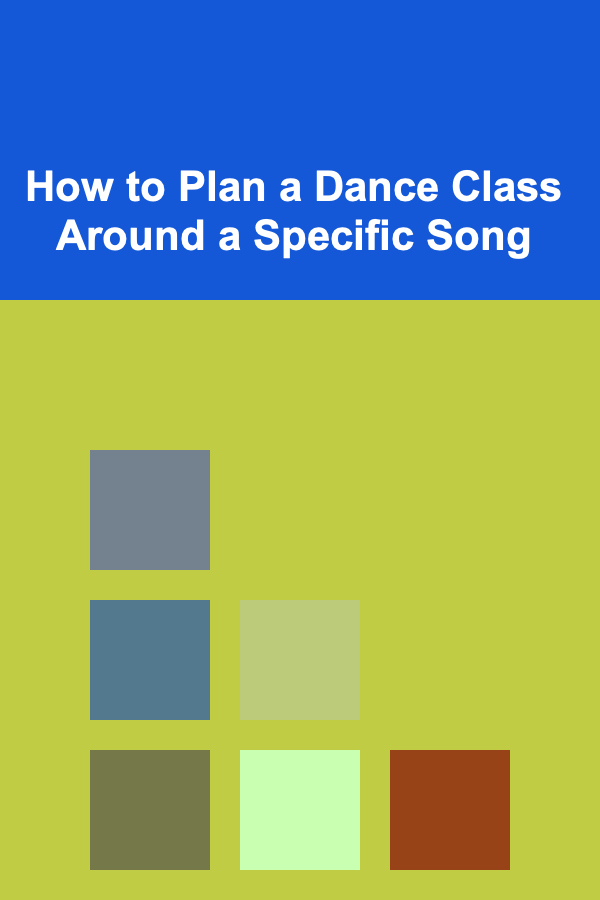
How to Plan a Dance Class Around a Specific Song
ebook include PDF & Audio bundle (Micro Guide)
$12.99$6.99
Limited Time Offer! Order within the next:

Planning a dance class centered around a specific song requires thoughtful preparation and creativity. Whether you're teaching a beginner or an advanced class, creating a choreography that flows seamlessly with the rhythm, mood, and lyrics of the song can enhance the experience for your students and elevate their connection with the music. In this article, we will explore how to plan a dance class around a specific song, from choosing the right track to breaking down the choreography and making adjustments for different skill levels.
Step 1: Selecting the Right Song
Choosing the right song is the foundation of your dance class. The song should align with the objectives of the class and the skill level of your students. Here are several factors to consider when selecting the song:
1.1. Song Genre and Style
The genre of the song will dictate the overall style of the choreography. For instance:
- Hip-hop: A song with a strong beat and rhythm can lend itself to dynamic, street-style choreography.
- Jazz: A song with clear phrasing and melodic elements allows for sharp, stylized movements.
- Ballet: Classical music works well for ballet, providing the elegance and fluidity needed for precise, controlled movements.
- Contemporary: Songs with emotional depth or abstract melodies work well for contemporary dance, allowing for expressive, fluid movements.
1.2. Song Tempo
The tempo of the song will influence the speed and intensity of the choreography. A fast-paced song may require quick, energetic movements, while a slower song allows for more fluid and expressive movements. It's crucial to consider the abilities of your students in relation to the song's tempo:
- Fast tempo: Consider a simpler structure with explosive movements and short, sharp transitions.
- Slow tempo: You may focus on extended movements, storytelling through dance, and using pauses effectively.
1.3. Song Structure
Understanding the structure of the song will help you plan your choreography. Most popular songs follow a pattern of verses, choruses, and bridges, and knowing these sections will help you create dynamic changes in the choreography. Look for natural transitions between sections to guide your movements:
- Verses: These can be used for building up tension or setting the tone of the dance.
- Choruses: Often the most energetic and climactic part of the song, the chorus should correspond with the peak of your choreography.
- Bridges and Outros: These sections may be great for transitions or introspective movements that contrast with the rest of the song.
1.4. Lyrics and Storytelling
Consider how the lyrics of the song can inform your choreography. If the song has a narrative or emotional depth, you can use the lyrics to guide the storytelling aspect of the dance. For example:
- If the song is about love or heartbreak, you might incorporate gestures or movements that reflect longing, conflict, or passion.
- If the song has an upbeat, celebratory theme, your choreography may be lively and full of joy.
Integrating the emotion of the song into the movement will allow students to connect on a deeper level with the material.
Step 2: Breaking Down the Song for Choreography
Once you've chosen your song, it's time to start building your choreography. To create a class that flows well, break down the song into smaller segments and design your choreography around these sections.
2.1. Identify Key Moments in the Song
Begin by identifying key moments or transitions in the song that could serve as focal points in your choreography. These may include:
- Rhythmic breaks: These are perfect for sharp, defined movements.
- Build-ups: Gradually increase the complexity and intensity of the movement as the music intensifies.
- Lyric-driven movements: You can incorporate movements that are literally or metaphorically inspired by the lyrics.
2.2. Structure the Choreography Around the Song's Sections
Start by planning the introduction, main body, and conclusion of the choreography based on the structure of the song.
- Intro: Use the intro to warm up and introduce the movements that will be used throughout the rest of the dance. The intro may also set the tone for the dance.
- Verse Sections: The verses can be used to develop character and subtlety. For instance, during the verses, you may want to use slower or more restrained movements.
- Choruses: The chorus is the climax of the song, and the choreography should reflect this. Use the chorus to build intensity, create high-energy movements, or incorporate large, sweeping gestures.
- Bridge/Outro: The bridge is often a great place for creative movement that contrasts with the rest of the piece. You can also use this section to wind down and conclude the dance.
2.3. Match Movements to the Music
Aligning your movements with the beats and rhythms of the song will make the choreography feel more natural and dynamic. Pay attention to:
- Accents: Identify strong beats in the music and match them with bold, accentuated movements.
- Syncopation: Use off-beat movements or pauses in the music to create surprise or playfulness.
- Melodic phrasing: If the song has a clear melody, you can incorporate smooth, flowing movements to follow the melodic rises and falls.
Step 3: Adapting Choreography for Different Skill Levels
When planning a dance class around a specific song, you need to tailor your choreography to the skill level of your students. Here are some tips for adapting your routine:
3.1. Beginner Level
- Simplify the Movement: Focus on basic, large movements that are easy to follow. For beginners, complex footwork or fast transitions may be too challenging. Instead, keep the movement grounded and accessible.
- Focus on Timing and Coordination: Teach students how to stay on beat and work on basic coordination between their upper and lower bodies.
- Repetition: Keep sections simple and repeat them several times so students become comfortable with the routine.
3.2. Intermediate Level
- Incorporate Turns and Variations: Intermediate dancers will be comfortable with basic steps, so you can add complexity through turns, variations, and transitions between movements.
- Focus on Expression and Style: Encourage students to add personal flair and style to their movements. You can also begin to focus on dynamic contrasts, such as using fast and slow movements in different sections of the choreography.
- Add Layered Movements: You can start layering more intricate movements with footwork, hand placements, or body isolations.
3.3. Advanced Level
- Advanced Techniques: At this level, you can introduce more intricate footwork, complex arm movements, and challenging partnering work.
- Incorporate Improvisation: Advanced dancers are often comfortable improvising within a set structure. Allow students to experiment with certain sections, giving them the freedom to add their own interpretation of the song.
- Create a Dynamic Performance: At the advanced level, the choreography should reflect the music in a way that challenges the dancer's physical limits and emotional expression.
Step 4: Teaching the Dance Class
Once you have your choreography ready, the next step is to teach it effectively to your students.
4.1. Warm-Up and Stretch
Always start with a proper warm-up to prepare your students physically. A warm-up should focus on increasing flexibility, improving range of motion, and preventing injury. During the warm-up, also introduce some of the movements that will appear in the choreography.
4.2. Teach in Small Sections
Break down the choreography into manageable sections and teach them step by step. Start by teaching the more straightforward movements, and once students are comfortable, move on to more complex sequences.
- Count the Music: Count along with the music to help students stay on beat. Provide clear cues so they know when to make the next move.
- Slow Down: When introducing new movements, slow down the music or the movements themselves. Once the students are comfortable with the steps, gradually increase the speed.
4.3. Review and Practice
After teaching each section, have the students practice it repeatedly until they feel confident. Once they've learned all the sections, put them together and run through the entire routine.
- Positive Feedback: Offer constructive feedback and praise to help students improve.
- Encourage Expression: Especially with advanced students, encourage them to infuse their personality into the movements.
4.4. Cool Down
End the class with a cool-down to relax the muscles and prevent injury. This can involve stretching and gentle movements, as well as a final reflection on the dance.
Conclusion
Planning a dance class around a specific song is an exciting challenge that allows you to connect students with the music in a meaningful way. By carefully selecting the song, breaking it down into manageable sections, and adapting the choreography for different skill levels, you can create an engaging and memorable dance experience. The key to success lies in understanding the music, crafting movements that complement it, and fostering an environment where students feel comfortable to explore their movement, style, and creativity.
Reading More From Our Other Websites
- [Home Space Saving 101] How to Maximize Storage with a Folding Laundry Rack
- [Home Lighting 101] How to Create an Energy-Efficient Lighting Plan for Your Home
- [Organization Tip 101] How to Create a Centralized Location for All Important Papers
- [Home Budget 101] How to Reduce Waste and Save Money in Your Home Budget
- [Personal Care Tips 101] How to Use Face Oil to Combat Skin Fatigue
- [Organization Tip 101] How to Equip Your Safe Room with Survival Essentials
- [Organization Tip 101] How to Use Cloud Storage to Keep Your Documents Organized
- [Home Storage Solution 101] How to Maximize Storage in Your Bathroom Cabinets
- [Organization Tip 101] How to Use Wire Baskets for Vintage Item Storage
- [Organization Tip 101] How to Organize a Community Garden Project

How to Create an Industrial Look in Your Home Without the High Cost
Read More
How to Use Supplier Directories to Find Top Dropshipping Partners
Read More
What Should You Consider When Organizing Seasonal Clothing?
Read More
Choosing the Best Training Regimen for Extreme Sports
Read More
How to Differentiate Between a Cold, Flu, and COVID: An Immunologist's Guide
Read More
How to Color Bookmarks with Watercolor Pencils
Read MoreOther Products

How to Create an Industrial Look in Your Home Without the High Cost
Read More
How to Use Supplier Directories to Find Top Dropshipping Partners
Read More
What Should You Consider When Organizing Seasonal Clothing?
Read More
Choosing the Best Training Regimen for Extreme Sports
Read More
How to Differentiate Between a Cold, Flu, and COVID: An Immunologist's Guide
Read More